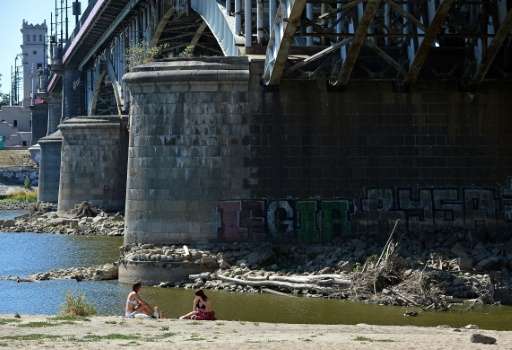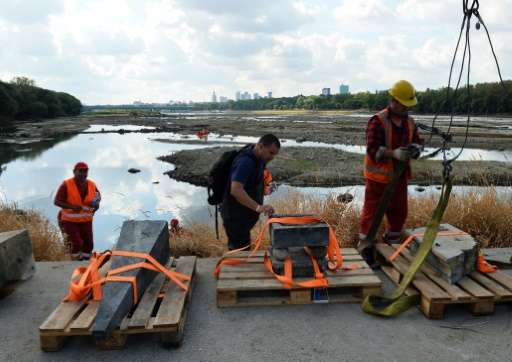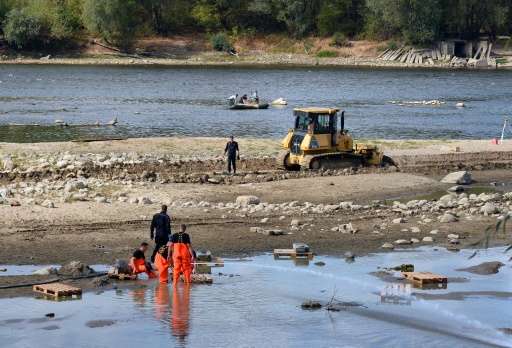Polish river reveals 17th century secrets amid drought

Archeologists are having a field day in Poland's longest river, the Vistula, which because of a drought has hit a record low water level allowing them to uncover a treasure trove of ancient artifacts.
"There are pieces of marble and stoneware and fragments of fountains, window sills, columns, concrete slabs, cannonballs," said Hubert Kowalski, a researcher at Warsaw University's archeological institute.
Dressed in orange and green rubber hip waders, the archeologists slosh around the Vistula, whose level has fallen to just 40 centimetres (16 inches) in downtown Warsaw—the lowest in over 200 years.
Armed with detectors of all sorts, sonars and sub-bottom profilers—tools for identifying layers of sediment—they search for curious objects from aboard their inflatable boat.
The large sandbanks poking out of the water give the river the air of a barren desert landscape. But for the archeologists, it's paradise.
Even the bulldozers are able to follow them into areas that are normally off limits for the heavy machines.
Using water pumps borrowed from firemen, the archeologists remove layers of sand and pebbles to retrieve their treasures, sometimes with the help of cranes when the objects prove too heavy.
"It's mainly fragments of carved stones that the Swedes tried to steal in the 17th century during their 1656 invasion," Kowalski told AFP.

"But they failed to get them out of the country because the Vistula's water level was too low" to keep their boats afloat.
Obelisks and a moose
Other items to emerge from the Vistula this summer include pieces of bridges and boats, as well as ceramic objects dating as far back as 700 to 400 BC.
They include obelisks and bases of columns that likely came from Warsaw's Kazimierz Palace, which was built in the 17th century and is today a Warsaw University building.
The Vistula is the EU member's largest river, as well as its longest at more than 1,000 kilometres (600 miles), splitting the country in half and flowing into the Baltic Sea.
It is also "one of Europe's most capricious waterways," said Culture Minister Malgorzata Omilanowska, who visited the archeologists on Thursday.
"Its bed consists of a layer of sand eight to nine metres (26 to 30 feet) deep and the river does what it likes with it, like piling it up into a massive mound only to dig a huge hole in the same spot the following year."

The Vistula's green riverbanks are a favourite with birds, pedestrians, cyclists and even sunbathers and campfire enthusiasts in the summer months.
Its water level usually averages 237 centimetres in the capital but reached a high of 787 centimetres in 1960. Records began in 1789.
The low water level of the river and its tributaries has hit the farm sector hard but has had no effect on the capital's supply of drinking water, which is sourced underground.
Historic finds have also surfaced elsewhere: the wreck of a Soviet military plane that crashed at the end of World War II turned up in the almost completely dried-up Bzura River.
Meanwhile a small patrol boat from World War I washed up in the San River in the country's southeast, complete with ammunition and three guns more than a century old.
But the surprises were not limited to sunken ships and ancient artifacts: a moose also wandered into the middle of the Vistula near downtown Warsaw last month to beat the heat, all to the media's delight.
Television stations showed hours of live feeds of the animal staring pensively off into space before police managed to catch it and release it into a greener area away from downtown.
© 2015 AFP





















